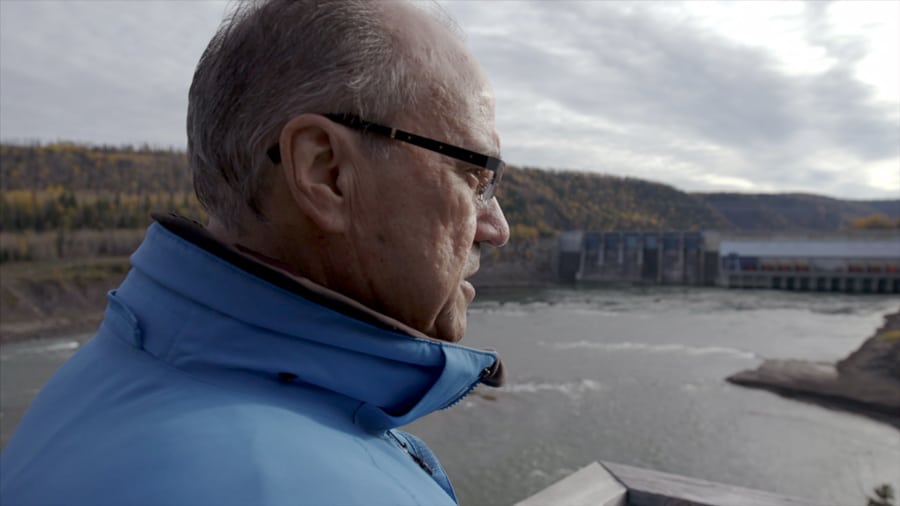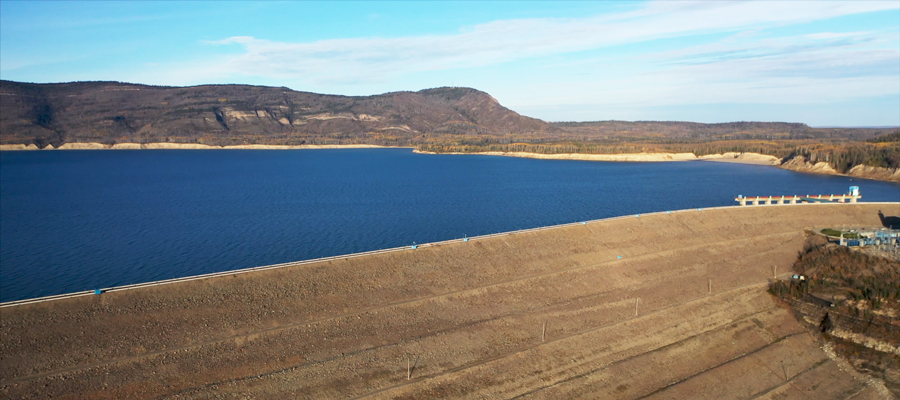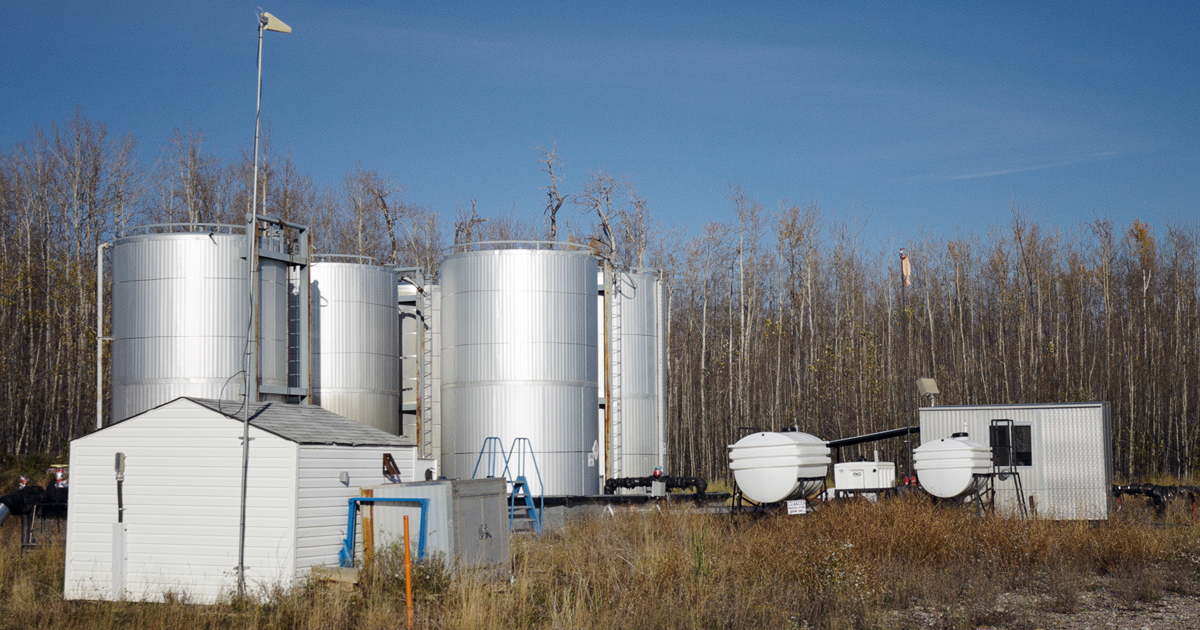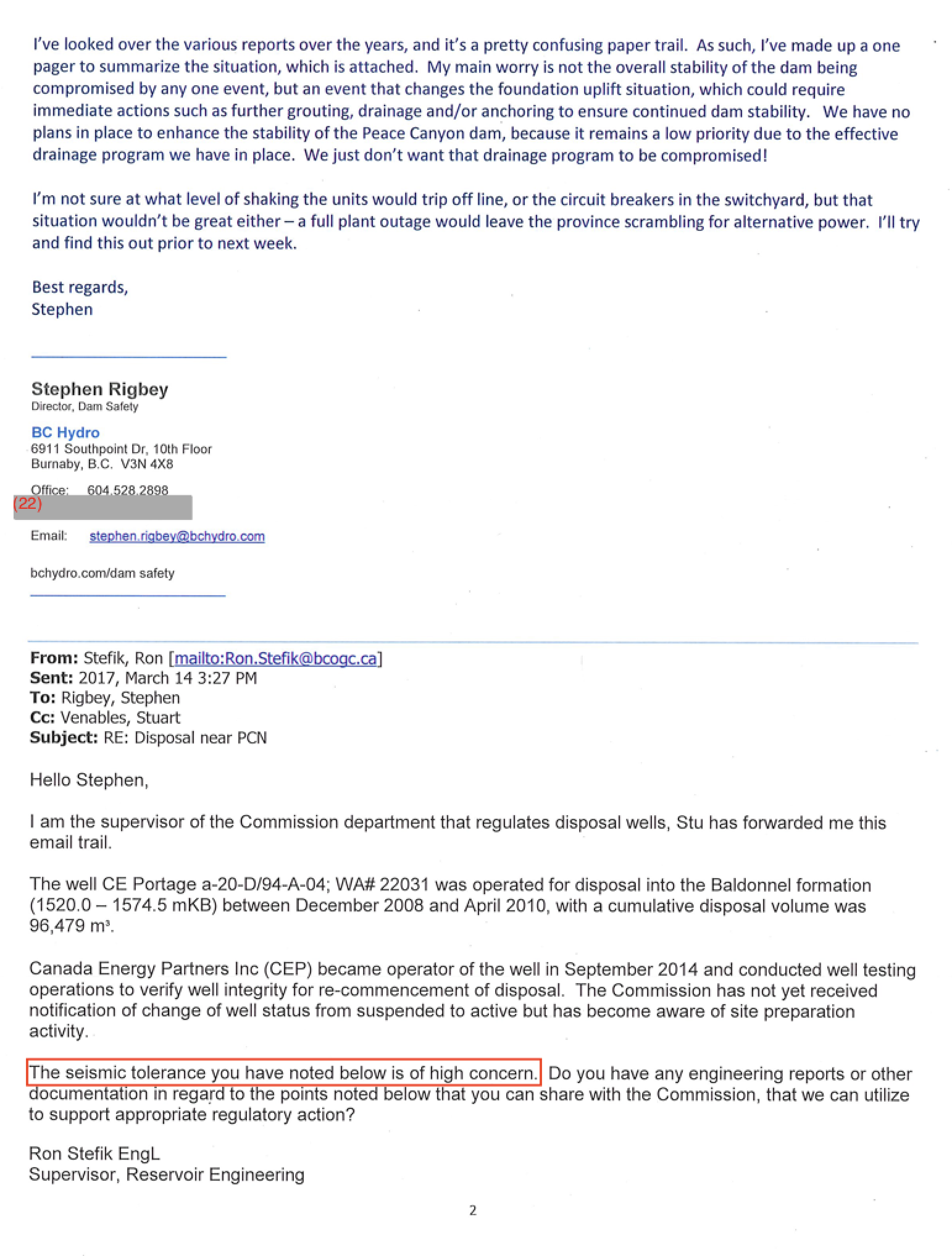December 14, 1963 – Baldwin Hills Dam near Los Angeles fails. Five people killed, more than 270 homes destroyed or damaged. Oil and gas company “fluid injection” operations identified as partly responsible for disaster.
July 1974 – BC Hydro starts building Peace Canyon Dam, downstream of WAC Bennett Dam. Engineers subsequently discover Peace Canyon Dam is built on top of weak rock.
April 1980 – Peace Canyon Dam begins producing hydroelectricity.
Spring to summer 2007 – Dave Unger, then construction manager at BC Hydro’s Peace Canyon and WAC Bennett dams, experiences three disturbing tremors at the Peace Canyon dam – the first “felt events” at the site possibly linked to encroaching natural gas industry operations.

Dave Unger, a former construction manager for BC Hydro, was the first to report troubling ground motions at the Peace Canyon dam. Photo: Jayce Hawkins.
October 27, 2009 – Scott Gilliss, BC Hydro’s Peace River region dam safety engineer, warns in internal email of “clusters of earthquakes being caused by the oil and gas industry.”

BC Hydro’s Scott Gilliss was among the earliest to sound alarms about the risks to BC Hydro’s Peace River dams from encroaching fracking operations, FOI documents reveal. Source: BC Hydro FOI release.
October 30, 2009 – Magnitude 5.5 earthquake “could be significant” for Peace Canyon Dam, BC Hydro’s manager of dam safety, Stephen Rigbey, warns Tim Little, BC Hydro’s chief engineer.
February 18, 2011 – Gilliss warns that encroaching shale gas fracking operations could pose risk to massive WAC Bennett dam. Dam’s seismic stability is “questionable,” Gilliss says in email.

The WAC Bennett dam impounds the world’s seventh-largest reservoir. In 2012 a BC Hydro employee speculated a fracking operation may have caused a sudden change in the reservoir’s water levels. Photo: Jayce Hawkins.
November 5, 2011 – 5.7 magnitude earthquake triggered at disposal well near Prague, Oklahoma. Earthquake is strongest to date triggered by fossil fuel industry operations.
November 18, 2011 – Oil and Gas Commission calls BC Hydro to say that “swarm” of 31 earthquakes north of Fort Nelson “may have been induced” by fracking operations.
April 9, 2012 – Rigbey likens natural gas industry fracking operations to “carpet bombing” in internal email. Says bombing campaign could last 50 years.
March 17, 2013 – Gilliss says geology at Peace Canyon Dam similar to geology at failed Baldwin Hills Dam. Warns “reactivation” of thrust faults near Peace Canyon could be “problematic.”
March 19, 2013 – Gilliss says proposed Liquefied Natural Gas operations “would certainly expand” disposal and fracking well operations in Peace Region, resulting in more earthquakes.
August 17, 2015 – Magnitude 4.6 earthquake triggered 114 kilometres north of Fort St. John by Malaysia’s Petronas. Quake is the largest to date caused by natural gas industry in the province.
January to early March, 2017 – Canada Energy Partners pumps 16 million litres of waste water into disposal well just 3.3 kilometres from Peace Canyon Dam.

A natural gas industry disposal well operation near BC’s Hydro’s Peace Canyon Dam. BC Hydro fears any re-sumption of pumping operations at the well site could trigger an earthquake with potentially devastating conse-quences for the dam and the safety of people living downstream. Photo © Garth Lenz.
March 14, 2017 – Rigbey warns Oil and Gas Commission that BC Hydro lowered Peace Canyon Dam’s “seismic withstand” rating due to “foundational problems” discovered at the dam during construction. Even minor Magnitude 4-4.5 earthquake could damage dam. Commission says Rigbey’s warning is “of high concern.”

Rigbey warns Oil and Gas Commission that BC Hydro lowered Peace Canyon Dam’s “seismic withstand” rating due to “foundational problems” discovered at the dam during construction. Source: BC Hydro FOI release.
March 16, 2017 – Oil and Gas Commission notifies Canada Energy Partners that its permit to operate a disposal well just 3.3 kilometres from Peace Canyon Dam has been suspended.
March 30, 2017 – Canada Energy Partners appeals to Oil and Gas Appeal Tribunal, asking for an “immediate stay” of the Oil and Gas Commission’s order to cancel the well disposal permit. Company seeks $5 million from Commission and BC Hydro should well permit be permanently canceled.
August 21, 2017 – Oil and Gas Appeal Tribunal rules that Oil and Gas Commission was justified to cancel permit because disposal wells “increase the likelihood” of earthquakes.
December 4, 2017 – Oil and Gas Commission elects not to permanently cancel Canada Energy Partners disposal well permit, instead issues set of new conditions that could allow well operations to resume.
December 13, 2017 – BC Hydro warns Oil and Gas Commission during face-to-face meeting that allowing disposal well to operate near Peace Canyon Dam is gambling on “what is tolerable risk for society.” In same meeting, BC Hydro warns earthquake triggered by disposal well could set in motion events that cause the dam “to fail.”
December 22, 2017 – BC Hydro considers buying disposal well from Canada Energy Partners for $5 million. Buyout idea rejected due to “precedent” it would set.
January 10, 2018 – BC Hydro legal counsel, Jeff Christian, warns Oil and Gas Commission in letter that “any waste water injection and fracking in close proximity to the Peace Canyon Dam” is opposed by BC Hydro “due to the large uncertainties in the hazard.” Same concerns apply to “any such critical infrastructure,” Christian says. Letter fails to convince Commission to terminate conditional disposal well permit.
September 30, 2018 – Massive landslide just downstream from Site C dam construction project blocks only road into and out of community of Old Fort, highlighting unstable terrain dam is being built in.
November 29, 2018 –Canadian Natural Resources triggers 4.5 magnitude earthquake just 20 kilometres from BC Hydro’s Site C Dam construction project, resulting in a “strong jolt” at the work site and the immediate evacuation of hundreds of workers.
December 7, 2018 – Oil and Gas Commission says Canadian Natural Resources will need express written permission to resume fracking operations at well site where 4.5 magnitude earthquake was triggered.
February 25, 2019 – Magnitude 4.9 earthquake in China’s Sichuan province kills two. County government suspends nearby fracking operation suspected of triggering the tremors.
March 19, 2019 – Michelle Mungall, B.C.’s Minister of Energy, Mines and Petroleum Resources, releases final report of independent science panel report on fracking. Report notes many “unknowns” including just how large an earthquake may one day be triggered by fracking.
June 5, 2019 – Independent geological report commissioned by Oil and Gas Commission says Kiskatinaw area where Canadian Natural Resources triggered 4.5 magnitude earthquake is riddled with “critically stressed faults” that could be activated by fracking operations.
October 21, 2019 – Oil and Gas Commission grants Canadian Natural Resources conditional approval to recommence fracking operations at same well site where 4.5 magnitude earthquake was triggered.
Read Part 1 of the full report
Read Part 2 of the full report
